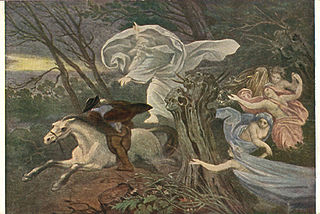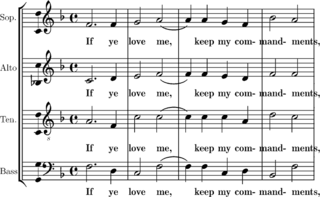
Figured bass, or thoroughbass, is a kind of musical notation in which numerals and symbols indicate intervals, chords, and non-chord tones that a musician playing piano, harpsichord, organ, lute play in relation to the bass note that these numbers and symbols appear above or below. Figured bass is closely associated with basso continuo, a historically improvised accompaniment used in almost all genres of music in the Baroque period of Classical music (c.1600–1750), though rarely in modern music.
Jazz is a music genre that originated in the African-American communities of New Orleans, United States, in the late 19th and early 20th centuries, and developed from roots in blues and ragtime. Jazz is seen by many as "America's classical music". Since the 1920s Jazz Age, jazz has become recognized as a major form of musical expression. It then emerged in the form of independent traditional and popular musical styles, all linked by the common bonds of African-American and European-American musical parentage with a performance orientation. Jazz is characterized by swing and blue notes, call and response vocals, polyrhythms and improvisation. Jazz has roots in West African cultural and musical expression, and in African-American music traditions including blues and ragtime, as well as European military band music. Intellectuals around the world have hailed jazz as "one of America's original art forms".

The term jazz guitar may refer to either a type of guitar or to the variety of guitar playing styles used in the various genres which are commonly termed "jazz". The jazz-type guitar was born as a result of using electric amplification to increase the volume of conventional acoustic guitars.

In music performances, rhythm guitar is a technique and role that performs a combination of two functions: to provide all or part of the rhythmic pulse in conjunction with other instruments from the rhythm section ; and to provide all or part of the harmony, i.e. the chords from a song's chord progression, where a chord is a group of notes played together. Therefore, the basic technique of rhythm guitar is to hold down a series of chords with the fretting hand while strumming or fingerpicking rhythmically with the other hand. More developed rhythm techniques include arpeggios, damping, riffs, chord solos, and complex strums.

Bebop or bop is a style of jazz developed in the early to mid-1940s in the United States, which features songs characterized by a fast tempo, complex chord progressions with rapid chord changes and numerous changes of key, instrumental virtuosity, and improvisation based on a combination of harmonic structure, the use of scales and occasional references to the melody.
In music, an ostinato[ostiˈnaːto] is a motif or phrase that persistently repeats in the same musical voice, frequently in the same pitch. Well-known ostinato-based pieces include both classical compositions such as Ravel's Boléro and the Carol of the Bells, and popular songs such as Donna Summer and Giorgio Moroder's "I Feel Love" (1977), Henry Mancini's theme from Peter Gunn (1959), The Verve's "Bitter Sweet Symphony" (1997), and April Ivy's "Be Ok" (1997).
Comping is the chords, rhythms, and countermelodies that keyboard players, guitar players, or drummers use to support a jazz musician's improvised solo or melody lines. It is also the action of accompanying, and the left-hand part of a solo pianist.
In music, the Phrygian dominant scale is the fifth mode of the harmonic minor scale, the fifth being the dominant. Also called the altered Phrygian scale, dominant flat 2 flat 6 (in jazz), the Freygish scale (also spelled Fraigish), or simply the fifth mode of the harmonic minor scale. It resembles the scale of the Phrygian mode but has a major third. In the Berklee method, it is known as the Mixolydian ♭9 ♭13 chord scale, a Mixolydian scale with a lowered 9th (2nd) and lowered 13th (6th), used in secondary dominant chord scales for V7/III and V7/VI.
Sonata form is one of the most influential ideas in the history of Western classical music. Since the establishment of the practice by composers like C.P.E. Bach, Haydn, Mozart, Beethoven, and Schubert and the codification of this practice into teaching and theory, the practice of writing works in sonata form has changed considerably.

"Erlkönig" is a poem by Johann Wolfgang von Goethe. It depicts the death of a child assailed by a supernatural being, the Erlkönig, often half-translated as "Erlking", though the eponymous character is clearly some kind of demon or 'fairy king'. It was originally composed by Goethe as part of a 1782 Singspiel entitled Die Fischerin.
Cycle has several meanings in the field of music. Acoustically, it refers to one complete vibration, the base unit of Hertz being one cycle per second. Theoretically, an interval cycle is a collection of pitch classes created by a sequence of identical intervals. Individual pieces that aggregate into larger works are considered cycles, for example, the movements of a suite, symphony, sonata, or string quartet. This definition can apply to everything from settings of the Mass or a song cycle to an opera cycle. Cycle also applies to the complete performance of an individual composer's work in one genre.

In music, homophony is a texture in which a primary part is supported by one or more additional strands that flesh out the harmony and often provide rhythmic contrast. This differentiation of roles contrasts with equal-voice polyphony and monophony. Historically, homophony and its differentiated roles for parts emerged in tandem with tonality, which gave distinct harmonic functions to the soprano, bass and inner voices.
Modinha is the affectionate form of the Portuguese noun "moda", meaning "fashion". The word "moda" is also used in Portugal, today, generally referring to traditional regional songs. In Portugal, "modinha" was, from the last third part of the 18th to the beginning of the 19th century, a general term designating sentimental songs in Portuguese.
In jazz education, a contrafact is a musical composition consisting of a new melody overlaid on a familiar harmonic structure. Contrafact can also be explained as the use of borrowed chord progressions.
Jewish music is the music and melodies of the Jewish people. There exist both traditions of religious music, as sung at the synagogue and domestic prayers, and of secular music, such as klezmer. While some elements of Jewish music may originate in biblical times, differences of rhythm and sound can be found among later Jewish communities that have been musically influenced by location. In the nineteenth century, religious reform led to composition of ecclesiastic music in the styles of classical music. At the same period, academics began to treat the topic in the light of ethnomusicology. Edward Seroussi has written, "What is known as 'Jewish music' today is thus the result of complex historical processes". A number of modern Jewish composers have been aware of and influenced by the different traditions of Jewish music.
This article describes the principal types of religious Jewish music from the days of the Temple to modern times.

Romanesca was a melodic-harmonic formula popular from the mid 16th to early 17th centuries, used as an aria formula for singing poetry and as a subject for instrumental variation. It was most popular with Italian composers of the early Baroque period. It was also used by vihuelistas including Luis de Narváez, Alonso Mudarra, Enríquez de Valderrábano, and Diego Pisador.
The term gypsy style refers to the typical way East European music is played in coffeehouses and restaurants, at parties, and sometimes on-stage, in European cities. Music played in this style is known by the general public as "gypsy music".
This article discusses the music theory of Traditional sub-Saharan African harmony.









